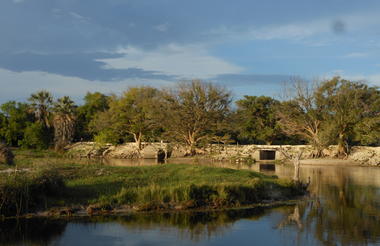Looking at a map of Botswana, you’d miss Khwai completely if you didn’t know it was there. Wedged between the big-ticket attractions of Chobe National Park to the east and Moremi Game Reserve to the south, Khwai exists as a significant big game destination of its own.
Lying on the eastern fringes of the Okavango Delta with a rich wildlife population and no borders drawn around it on the map, Khwai is often overlooked in favour of its more famous neighbours, though in the winter months it can hold its own for the quality of big game viewing.
During your time here, you’ll spend most days exploring the narrow Khwai River, which forms the natural boundary to the Moremi Game Reserve on the south. The Khwai River is a beacon for wildlife and plays host to leopards stalking lechwe in the long grass, lions swimming from the banks to save their cubs’ during territorial disputes and crocodiles competing with wild dogs for a midday meal of impala.
As Khwai lies outside the parks, it offers the freedom and flexibility normally only possible with the heavier price tag of a private concession. Go off-road for a closer look at sightings, night drive in search of nocturnal species, and, with a little advance planning, head out on game walks to track wildlife on foot.
Khwai is also home to a village community where people live side by side with the resident wildlife. Some camps will offer village visits for a dose of cultural insight to go with your safari. For those not visiting the water camps of the delta, many camps in Khwai offer the chance to get out on a mokoro (traditional canoe), although excursions are less traditional in nature, skirting the riverbanks, rather than open delta floodplains.



Before the Okavango River fans out into its familiar delta shape, its waters are channeled between steep banks created by parallel fault lines. This channel is commonly known as the Pan Handle, named as such as the Delta takes on the appearance of a giant frying pan lying in the heat of the Kalahari.
Permanent deep water has encouraged the growth of villages along the river, particularly on the western side which is accessed by a tarred road. The communities up in this area are mainly fishing based or cattle farming and there are opportunities for some colourful encounters with the locals and the area offers a true glimpse of village life, often not seen in Botswana as guests often only visit the uninhabited wildlife areas.
The Panhandle area is not within a protected reserve or park, but there are still huge areas of unspoiled wetlands and a number of well-established lodges on the western side. The wetlands offer exquisite birdlife , a huge population of hippos and some of the largest crocodiles to be found. The general wildlife common in the lower delta is less abundant in this area. The focus of activities in the area are water based - motorboating and fishing, and it is possible to travel by road or boat to the eastern side of the river where there are community based mokoro excursions offered. The Pan Handle area is also in proximity to the world heritage site of Tsodilo Hills. Being the spiritual home of the San and Bantu people, the hills feature many well preserved specimens of 'rock art' and there is a small museum where it is possible to hire a local guide for a personal tour of the area. The annual barbell run of catfish ( September/October) attract hunting tiger fish in large numbers and is the best time for serous anglers to experience this fascinating phenomenon and catch this awesome predatory game fish.



Situated along the banks of the Thamalakane River, in the North-West District of Botswana, Maun, a term that derives its name from the San language, meaning "the place of reeds," serves as the administrative town center of Ngamiland. Maun is notoriously known as a "Frontier" town, and is referred to as the 'gateway' to the Okavango Delta and Moremi Game Reserve as most tourists enter these destinations through this buzzing town.
Although classified as one of the fastest growing towns in Botswana, and boasting one of the busiest airports in Southern Africa, Maun still retains much of its old/traditional (village-like) character, which encompasses the old judicial court of chiefs who are still active. Reed and mud hut infrastructures are seen in and around town as well as donkeys/carts and livestock. However, numerous hotels, lodges, bed and breakfasts, shopping malls, post offices, a museum and a big hospital are available too. Maun also serves as the headquarters for the safari industry, tour operators and air charter companies that offer trips into the Okavango Delta and National Parks such as Moremi Game Reserve, Khwai, Savute, Makgadikgadi, Chobe, Nxai Pan to name a few, as well as monumental historical sites like the Tsodilo Hills. Opportunities to visit nearby cultural villages can also be arranged from this central point.



 (1) (002)1.png?fmt=png)


 (1) (002)1.png?fmt=png)
